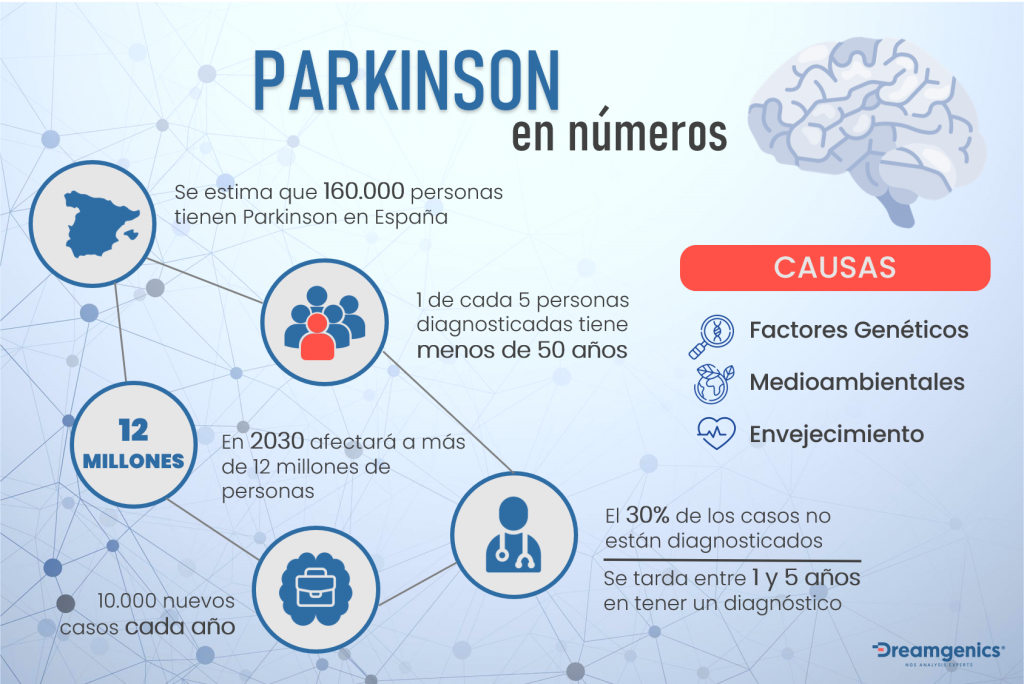World Parkinson's Day is celebrated on April 11, coinciding with the anniversary of James Parkinson, a British neurologist who in 1817 discovered what he called paralysis agitans and what we know today as Parkinson's disease.
Parkinson's disease (PD) is a neurodegenerative disorder that affects the nervous system in a chronic and progressive manner. It is the second most prevalent neurodegenerative disease after Alzheimer's disease and belongs to the group of the so called Movement Disorders. PD is characterized by the loss (or degeneration) of neurons in the substantia nigra, a structure located in the middle part of the brain. This loss causes a lack of dopamine in the body, a molecule that transmits information necessary for us to perform movements normally. The lack of dopamine causes movement control to be altered, giving rise to typical motor symptoms such as resting tremor or rigidity.
To date, the exact cause of PD is unknown in most cases, but it is thought that it may be due to a combination of genetic, environmental and aging-related factors. However, genetic factors are increasingly recognized as causative of the disease.
Genetic factors
Ninety percent of Parkinson's cases are sporadic forms, i.e., they occur in a single family member and are not due to a specific genetic alteration. However, about 15% of people with PD have a positive family history and it is estimated that 5-10% of all Parkinson's cases are attributed to pathogenic variants in individual genes.
Monogenic Parkinson's disease
La EP monogénica es debida a mutaciones en un único gen, puede seguir diferentes tipos de herencia y la edad de inicio es variable. Podemos diferenciar la EP de aparición en la edad adulta de inicio temprano (20 – 50 años) o tardío (>50 años) causada por alteraciones en los genes GBA, LRRK2, PRKN o SNCA y la EP de inicio en edad juvenil (<20 años) asociada a los genes ATP13A2 o DNAJC6, entre otros.
Genetic susceptibility factors
In addition to the known major monogenic causes of PD, additional genes and susceptibility loci have been identified through genome-wide association studies (GWAS) and other research. In particular, more than 90 genetic risk loci have been identified for the sporadic form of the disease. These variations, which are commonly found in the general population, do not play a major causal role in PD, but may contribute to the overall risk of developing the disease and may exert an effect on some features of the disorder. While these genetic modifiers may contribute to a small extent to PD risk, most are not yet clinically applicable and more research is needed to clarify their role in clinical diagnosis and risk assessment.

Genetic diagnosis
Despite the knowledge of these genetic factors as a cause of PD, the diagnosis of PD is still fundamentally clinical and is made on the basis of the patient's clinical history and neurological examination, as there is currently no biomarker to aid diagnosis. However, in routine clinical practice, diagnostic misclassification is common, with error rates ranging from 15% to 24% in different cases. The biggest challenge facing clinicians is the early diagnostic differentiation of PD from atypical parkinsonian disorders.
Atypical parkinsonism is a general term for a variety of neurodegenerative disorders in which a parkinsonian syndrome is a prominent clinical feature, but the full clinical spectrum, underlying pathology, progression and prognosis differ fundamentally from those of PD. This is where the genetic diagnosis may be relevant, as knowledge of the underlying genetic alteration allows:
- Make a concrete diagnosis and provide more specific information on the clinical course.
- More effective counselling and predictive testing of asymptomatic relatives.
- Benefit from specific treatments (e.g. clinical trials are currently underway for patients with GBA and LRRK2 mutations).
How and when to perform a genetic diagnosis
Los estudios genéticos pueden realizarse a partir de una muestra de sangre y en ellos se estudian por NGS los genes causantes de la EP con el objetivo de encontrar mutaciones que sean la causa de la enfermedad. Estos estudios deben realizarse en pacientes afectos de EP con aparición temprana de la enfermedad (<40 años) y/o pacientes con antecedentes familiares. También pueden realizarse estudios predictivos en familiares asintomáticos donde se haya identificado previamente la mutación familiar causante de la EP. Antes de la realización de cualquier estudio genético es recomendable la realización de una consulta de asesoramiento genético. En ella se proporciona a los pacientes y familiares información sobre la naturaleza y el modo de herencia de la EP y las implicaciones de la realización de un estudio genético para que puedan tomar decisiones adecuadas una vez han recibido la información necesaria.
- Cook, Lola, et al. The role of genetic testing for Parkinson's disease. Current neurology and neuroscience reports, 2021, vol. 21, no 4, p. 1-11.
- Cook, Lola et al. Genetic Testing for Parkinson Disease. Are We Ready? Neurol Clin Pract Feb 2021, 11 (1) 69-77.
- Parkinson Disease Overview. https://www.ncbi.nlm.nih.gov/books/NBK1223/
- Tolosa E, et al. Challenges in the diagnosis of Parkinson's disease. Lancet Neurol. 2021 May;20(5):385-397
- Spanish Parkinson Foundation. https://www.esparkinson.es/
